Hockey drills
- Make two rows of an equal number of players.
- Players take turns drifting toward the three double pawns.
- Arriving at the double pawns, do the herring trick three times in a row and then flatten the ball on goal.
Herring trick:
- You play the ball to the right of the double pawn and pass it yourself to its left.
- Make sure you have control of the ball again before the next double pawn.
- So push the ball in a controlled manner.

Party with four goals.
- The coach makes two equal teams.
- Each team defends two goals.
- It is allowed to play field hockey behind goal, but scoring is only allowed at the front.
Points of attention:
- Play with the 3 second rule; take the ball quickly after a foul. Takes longer than 3 seconds, free hit for the opposing team.
- If it is crowded on one side of the field, move the ball at pace to the other side where there is more space.
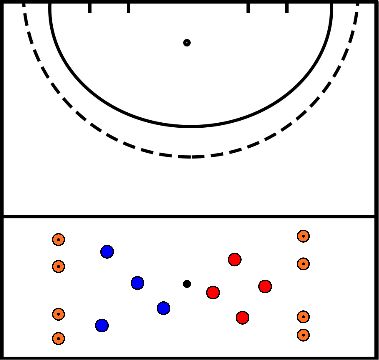
Party with four goals.
- The coach makes two equal teams.
- Each team defends two goals.
- It is allowed to play field hockey behind goal, but scoring is only allowed at the front.
Points of attention:
- Play with the 3 second rule; take the ball quickly after a foul. Takes longer than 3 seconds, free hit for the opposing team.
- If it is crowded on one side of the field, move the ball at pace to the other side where there is more space.
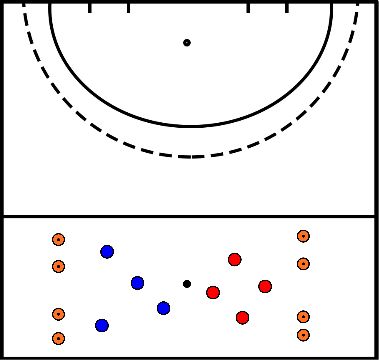
- Party form with the goals not in the middle of the field but on the right sides of the field.

- A starts with the ball and plays the ball to B.
- B takes the ball and plays the ball to C.
- C takes the ball and makes an action near the pawns and rounds on goal.

- A starts with the ball and passes it into the run at B.
- B takes the ball and floats onto the pawns at speed.
- B plays the ball to the offering C.
- C takes the ball and plays a 1 :1 against the defender.
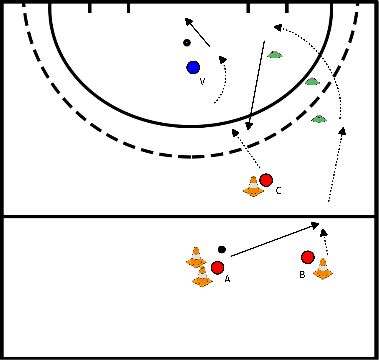
- A starts with the ball and floats to the pawns.
- A does a passing move to them and pushes the ball into B's run.
- B starts to run after A's passing move and takes the ball.
- B plays a 1:1 against the defender.
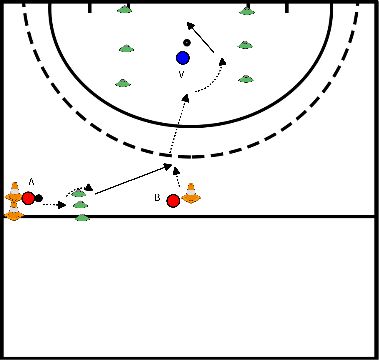
- A starts with the ball and push the ball straight ahead.
- B runs in a bit and takes the ball with the backhand -sitting low-.
- B takes the ball with the forehand and goes around the pawn.
- B push the ball straight forward to C who takes the ball with the backhand -staying high.
- C takes the ball it with the forehand and hits the ball on goal.
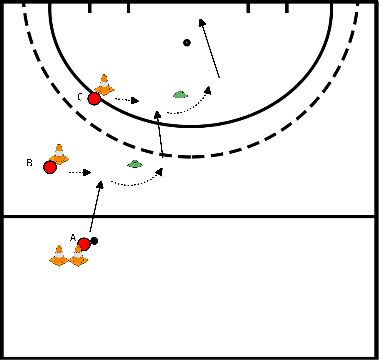
- A starts with the ball and drifts forward a bit and hits the ball through the gate to B.
- B takes the ball and floats forward a bit and hits the ball through the gate to the incoming C.
- C takes the ball and plays a 2:1 with B against the defender.

- Walking out.
- Rest.
- Width of field.
- Diagonal half-field build-up.
- Speed from 60% to 100%.

Relay
- Create two equal teams.
- Start the relay at the coach's signal.
- The player slaloms around the pawns -both ball and body around the pawns- and rounds on goal -push or flush-.
- If the player scores, he may immediately sprint back and tap the next player.
- If the player misses, he must take a detour via the blue pawn -on the side of the field- and then sprint back and tap the next player.
- When it's your turn, you sit down on the ground.
- Depending on the number of players, you can also choose to have all players take 2 or 3 turns.
- The next player may not start until he is tapped by the player in front of him.
- The team that has all players on the ground first wins the relay.
- There are different types of slalom to apply in this exercise:
- Normal slalom
- Slalom in which the player's body and ball are to the left or right of the row of pawns.
- Slalom where the ball is to the left of the row of pawns and the body is to the right.

- A starts with the ball and push the ball to B.
- A is going to defend and B is going to try to score in the goalmouth.
- Pay attention to the defender's stance, how to stand. Explain this.
- Explain exercise multiple times.









